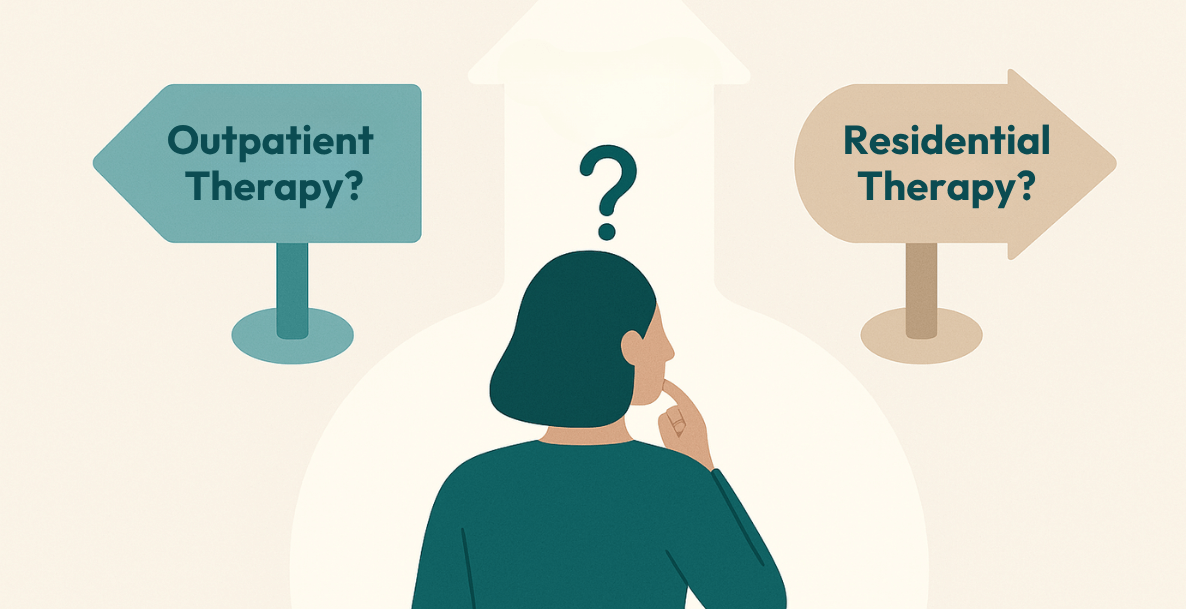Anxiety is a complex experience. For some people, it shows up during specific high-stress situations. For others, it’s part of the background of daily life. Understanding whether you’re dealing with state anxiety or trait anxiety can make a significant difference in how you approach healing.
While the symptoms may look similar at first glance, the underlying drivers are not the same. And that matters.
At Khiron Clinics, we believe that clarity helps create change. This guide breaks down trait anxiety, how it differs from state anxiety, and how a nervous-system-informed approach can support long-term recovery.

Download the Brochure
Discover Our Innovative Trauma Recovery Pathway
What Is Trait Anxiety?
Trait anxiety refers to a person’s consistent tendency to experience anxiety across many situations. Rather than being triggered by a specific event, it operates like a constant low-level current. People with trait anxiety often describe themselves as “always on edge” or “chronically worried,” even when there’s no obvious threat.
It’s not about being shy or introverted. It’s not about having a disorder. It’s about a patterned way your body and mind have learned to move through the world. In many cases, trait anxiety begins early in life. It may not come from one clear traumatic event. It may come from prolonged emotional stress, early attachment disruption, or a nervous system that never had the chance to fully settle.
How Trait Anxiety Manifests in the Nervous System
Trait anxiety is not just a mindset. It is a physiological experience. The autonomic nervous system plays a key role in regulating how we respond to stress and how safe we feel in our environment. When that system is dysregulated, it can stay stuck in patterns of hypervigilance or shutdown.
People with trait anxiety may have difficulty relaxing, even in safe environments. Their bodies may remain in a mild state of fight-or-flight without a clear cause. They may struggle with chronic muscle tension, digestive problems, or insomnia. The mind follows the body, creating cycles of overthinking, intrusive worry, or emotional reactivity.
These patterns are not signs of weakness. They are adaptive responses. They often develop in environments where the body learned it had to stay alert in order to stay safe.
The Difference Between Trait and State Anxiety
Although they are often grouped together, trait anxiety and state anxiety have distinct characteristics.
State anxiety is temporary. It arises in response to a specific situation, such as a job interview, a near accident, or a medical procedure. Once the perceived threat passes, the anxiety usually subsides.
Trait anxiety, by contrast, is ongoing. It exists independently of immediate threats and tends to color a person’s overall view of the world. People with trait anxiety may respond more strongly to stressors or even anticipate problems before they occur. They may feel anxious about things others find routine, like sending an email or being late to a meeting.
Both types of anxiety involve similar symptoms. But the origin, duration, and treatment pathways are not the same. Trait anxiety often requires a deeper look at what shaped the nervous system’s baseline state.
Root Causes of Trait Anxiety That Are Often Missed
In traditional mental health settings, anxiety is often treated as a diagnosis or chemical imbalance. While that approach may offer some relief, it can miss the deeper drivers of trait anxiety.
Many people with high trait anxiety have a history of chronic emotional stress, even if they don’t identify with the word “trauma.” They may have grown up in environments that were unpredictable, emotionally unavailable, or overly critical. Over time, the nervous system learns to be on guard, anticipating danger even when it is no longer there.
Other contributing factors may include:
- Early separation or loss
- Growing up with a parent who was anxious, depressed, or emotionally inconsistent
- Experiences of shame, rejection, or emotional neglect
- Being overly responsible at a young age
- Subtle developmental trauma
These patterns do not always show up on mental health assessments. But they live in the body. That is why a nervous-system-based lens is essential for understanding trait anxiety.
Why Many Treatments Overlook the Real Source
Cognitive therapies, mindfulness apps, and medications can all be useful tools. But for people with persistent trait anxiety, surface-level treatments often fall short. Focusing only on managing symptoms may reinforce the idea that something is wrong with you, instead of addressing what happened to you.
In our work with clients, we often see that underneath trait anxiety is a history of experiences that shaped how safe a person feels in the world and in themselves. Healing begins not with fixing the anxiety, but with helping the body feel what it means to be regulated, grounded, and connected.
This requires more than a cognitive intervention. It requires a full-body approach.
How Trait Anxiety Can Heal: A Nervous-System-Based Path Forward
At Khiron Clinics, our approach is built on understanding how trauma and early stress live in the nervous system. Rather than targeting symptoms in isolation, we support the conditions for real, lasting regulation.
Our model includes:
- Somatic Experiencing (SE) to help discharge stuck survival energy
- Internal Family Systems (IFS) to work with parts of the self that carry anxiety
- EMDR to process and integrate unprocessed experiences
- Neurofeedback to support brain regulation and resilience
- Polyvagal-informed therapy to help re-pattern safety and connection at a physiological level
These therapies are delivered within a structured, polyvagal-informed environment that prioritises emotional safety, attunement, and co-regulation. Clients are not expected to “push through” or perform. Instead, we meet each person where they are and build capacity from the inside out.
Healing trait anxiety is not about eliminating fear. It’s about changing your relationship with your nervous system so that fear is no longer running the show.
Next Steps: What You Can Do If This Sounds Familiar
If you recognise yourself in this description of trait anxiety, you are not alone. You do not need to have a formal diagnosis to benefit from support. You do not need to wait until things get worse. Help is available.
At Khiron Clinics, we offer several paths to healing:
- Initial Assessment to help clarify what kind of support will be most effective
- Outpatient Therapy for weekly sessions in person or online
- Intensive Outpatient Program (IOP) for deeper support while living at home
- Residential Treatment for immersive, round-the-clock care in a homelike setting
We work with clients from around the world. Whether you are just beginning to explore your anxiety or you have tried other treatments without success, we welcome the opportunity to walk with you on the path toward nervous system healing.
To find out more or speak to a member of our team, call us at +44 (20) 3856 4112 (UK) or +1 (877) 561 4453 (US), or visit khironclinics.com to request a call back.





